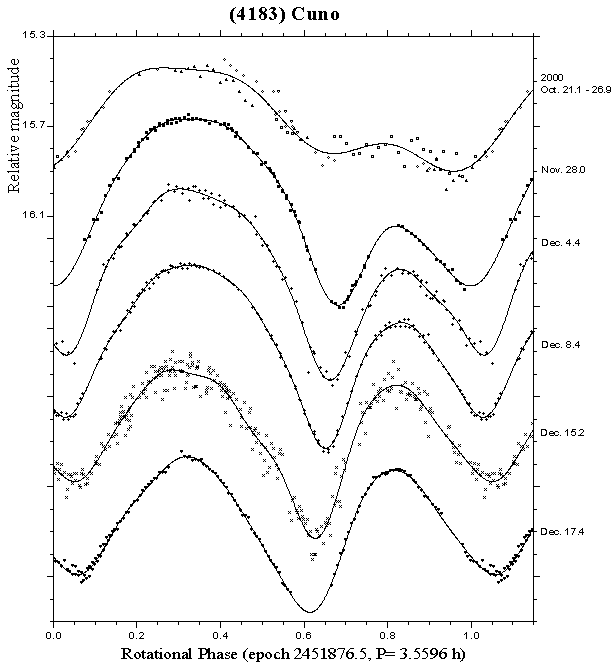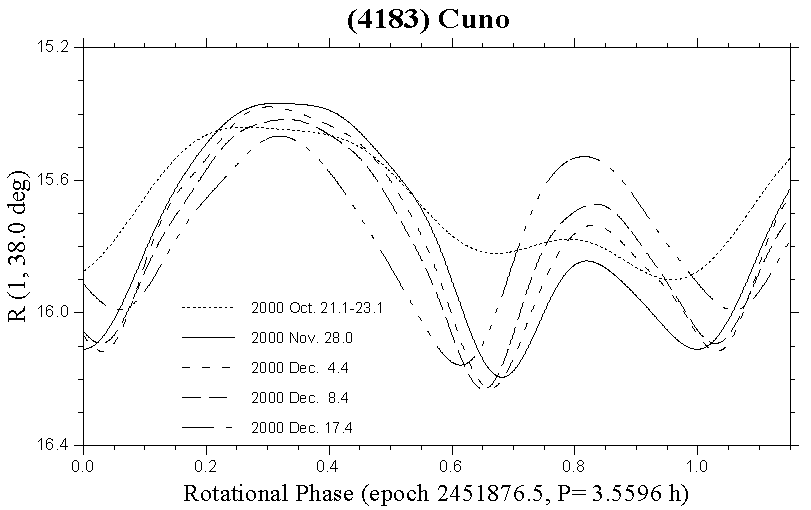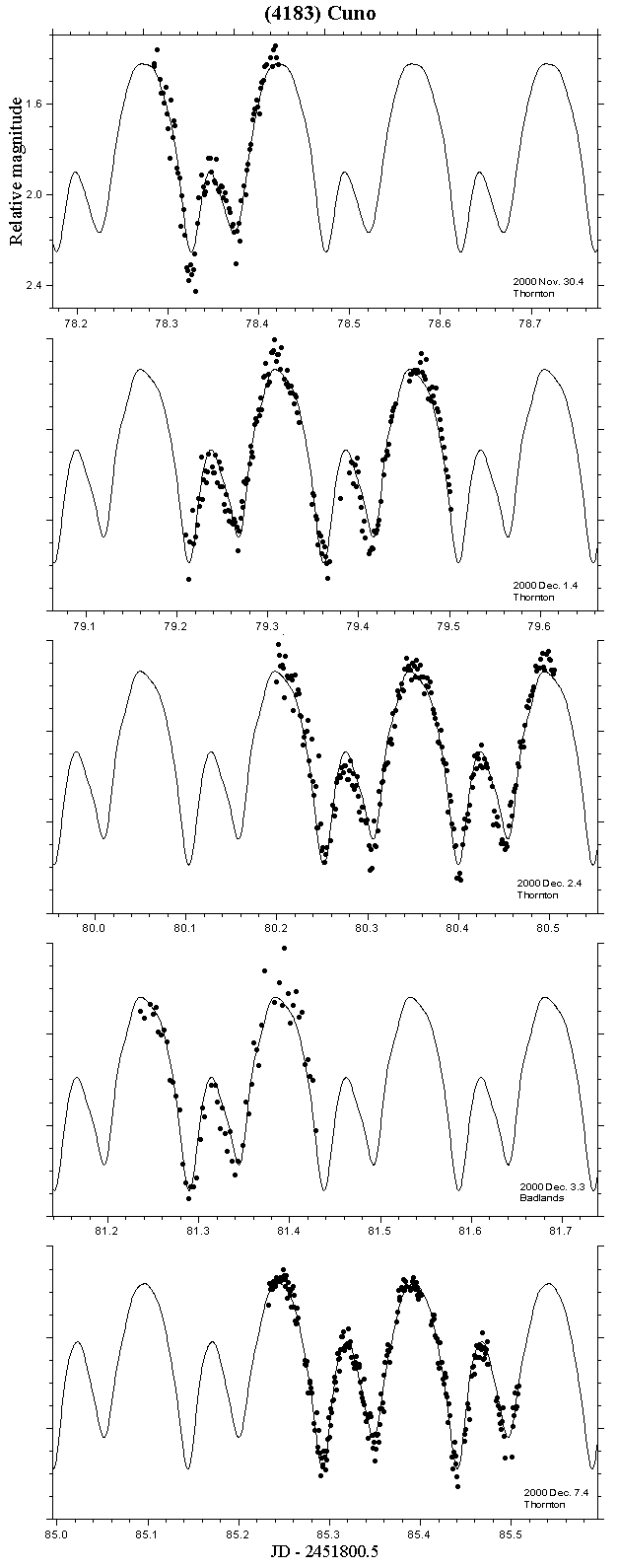(4183) Cuno
Updated 2001 February 8.
Orbit, abs. magnitude:
Apollo,
q = 0.722 AU, a = 1.983 AU, i = 6.8 deg, H = 14.4
Rotation period, amplitude:
P = 3.5596 hr, ampl. < 0.1 to 0.84 mag
Observations:
Contributing stations:
Ondrejov Observatory
Thornton Observatory, R. Koff
Badlands Observatory, R. Dyvig
River Oaks Observatory, B. Holliday
Manchester, J. Saxton
This Apollo asteroid has been observed on four nights during 2000 October 21.1-26.9
and ten nights during November 28.0 to December 17.4. An analysis
of the data revealed a lightcurve with the synodic
period of (3.5596 +/- 0.001) h.
Six representative composite lightcurves are presented
in Fig. 1. Most of the lightcurves
contain very strong signals in the 1st harmonic, that is quite unusual.
Moreover, the lightcurve evolved a lot during the 57-day interval.
The unusual shape and the evolution of the lightcurve is apparent from
Fig. 2 as well as from their parameters
listed in the following Table. The Table contains also Ondrejov data
from 1997 October 22-23 and data derived from a sparse lightcurve by
Bembrick et al. (2000) taken on 1998 June 19.
| Date | Lpab (deg) | Bpab (deg) | Phase (deg) | Amplitude (mag) | 2*A1 (mag) | 2*A2 (mag) | Dif.Max (mag) |
| 1997 Oct. 22 | 36 | +9 | 7 | < 0.1 | < 0.1 | < 0.1 | < 0.1 |
| 1998 June 19 | 230 | -14 | 58 | (0.70) | (0.04) | (0.46) | (0.18) |
| 2000 Oct. 22 | 74 | +9 | 34 | 0.46 | 0.44 | 0.12 | 0.34 |
| 2000 Nov. 28 | 96 | +10 | 38 | 0.83 | 0.69 | 0.27 | 0.47 |
| 2000 Dec. 4 | 102 | +11 | 42 | 0.84 | 0.56 | 0.39 | 0.36 |
| 2000 Dec. 8 | 107 | +11 | 46 | 0.81 | 0.44 | 0.45 | 0.26 |
| 2000 Dec. 15 | 120 | +12 | 59 | 0.75 | 0.24 | 0.51 | 0.07 |
| 2000 Dec. 17 | 126 | +12 | 66 | 0.69 | 0.17 | 0.54 | 0.06 |
Analysis and Interpretation:
Rotation Period:
The complex shape and evolution of the lightcurve during
2000 October 21 to December 17 don't allow a direct
application of methods of period determinations like that of
Harris et al. (1989). We used a few different approaches
to obtain a confident solution and we adopted a period of 3.5596 h
that resulted from a method using extrema of the second
harmonics of the best fit Fourier series to the individual lightcurves;
the extrema were assumed to occur at a same rotation phase of the asteroid
and the period has been estimated by minimizing a sum of square residuals
of the observed extrema's rotation phases.
The same method
has been successfully used in a few past similar cases, e.g.,
for (2063) Bacchus (Pravec et al. 1998).
A formal error of the adopted synodic period solution is 0.0003 h but our
experiments showed that a realistic error is somewhat greater
and we estimate it to be about 0.001 h. An a priori uncertainty
of the difference between the synodic and sidereal periods of rotation
caused by the motion of the PAB is 0.0013 h (see Pravec et al. 1996,
Eq. 4). Thus, we conclude that a sidereal period of Cuno's rotation is
(3.5596 +/- 0.002) h.
The First Harmonics:
The quite strong signal in the first harmonic of some of the
lighcturves (see the amplitudes 2*A1 in the Table above) is probably caused by a
large deviation of the asteroid's shape from a symmetric
figure. A large hemispheric albedo difference is not plausible since
in such case we would expect a relatively slow evolution of the
amplitude of the first harmonic. In other words, the fact that
we saw the major change from the dominance of the first harmonic
on November 28 to the much more symmetric lightcurve on December 15,
while the PAB moved by only 24 degrees during that interval,
indicates that a smaller
scale shape feature was the cause of the strong first harmonic,
not a hemispheric scale albedo difference.
Spin Vector Direction, Shape:
The lightcurve observed on 1997 October 22 and 23 showed an amplitude much
lower than the other lightcurves taken in the other apparitions.
Regardless of an actual shape of the asteroid and despite that
it at least partly could be due to the smaller solar phase angles
of that date, the small amplitude suggests that we
saw the asteroid at an aspect closer to pole-on on 1997 October 22-23
than on any of the other dates. Although we cannot estimate exactly
how far from pole-on it was, the uncertainty is likely a few tens degrees.
The position of the PAB on 1997 October 22 and hence the tentative pole
estimate is [36 deg, +9 deg] in equinox J2000. We have no constraint
on if it was a north or south pole.
If the asteroid's figure could be approximated with a triaxial ellipsoid,
it would be possible to estimate the asteroid's pole position and shape
using an amplitude method (see, e.g., Magnusson et al. 1989).
Since an ellipsoid
is clearly a poor approximation of the shape of the asteroid (see the previous
section),
we doubt that the amplitude method could provide a meaningful estimate of the
pole position and shape of the asteroid. Nevertheless, we checked
if the amplitudes are consistent with the tentative pole estimate mentioned
above and found that they suggest that the pole actually may be shifted
to somewhat smaller ecliptic longitudes than the pole estimate given above.
A pole around the longitude of about 10 degrees is suggested to have
an aspect of the 1997 October 22 still not far from pole-on while the
1998 June 19 observations would be taken at a middle-latitude aspect
that could cause the appreciable amplitude observed on that date.
The decrease of the mean brightness (derived as the zero order
of the best fit Fourier series) of the asteroid by 0.10 mag (after
a reduction to the same phase angle) from 2000 October 21-23
to November 28 (see Fig. 2) is also consistent
with the tentative pole position suggested above. The lightcurves taken
in mid-December 2000 were taken at an aspect close to equator-on and their
amplitudes corrected for a phase effect indicate that the equatorial
profile is somewhat elongated with a/b about XXXX.
The mean, absolute R magnitude derived from the calibrated lightcurves of
2000 October 21-23 and November 28 assuming G=0.15 is
Hr=14.14 and 14.24, respectively. Uncertainties of these
estimates due to an uncertainty of G are greater than 0.3 mag.
Considering that the mean V-R of asteroids is about 0.4 mag,
these estimates are consistent with the absolute V
magnitude H=14.4 from MPC 32296.
Fig. 1: Composite lightcurves from the 2000 apparition
The October and November lightcurves have been taken from Ondrejov Observatory, observers
L. Sarounova and P. Kusnirak. The December 4.4 lightcurve has been taken
by R. Dyvig from Badlands Observatory. The December 8.4 and
17.4 lightcurves have been taken by B. Holliday from River Oaks Observatory.
The December 15.2 lightcurve has been taken by J. Saxton from Manchester.
The curves are the best fit Fourier series of orders 3, 6, 8, 8, 7, and 7,
respectively.

Fig. 2: Composite lightcurves
The curves representing the best fit Fourier series of five of the composite
lightcurves from Fig. 1 plotted one over the other. The October and
November lightcurves are calibrated and they are plotted on the absolute
R magnitude scale (reduced to the solar phase angle of 38.0 deg assuming
G=0.15). The December lightcurves are relative and they are
plotted with their zeroth Fourier orders fixed at the value of the
zeroth order of the
November 28 lightcurve, to facilitate checking relative changes
of the lightcurve shape.

Fig. 3: Individual lightcurves from 2000 November 30.4 to
December 7.4
The lightcurves that also contributed but are not plotted in Fig. 1
are presented here.
The curves are the Fourier fits to nearby lightcurves from Fig. 1.

References:
Bembrick, C., B. Pereghy, and T. Ainsworth 2000. A lightcurve for 4183 Cuno.
Proc. XIX Natn. Aust. Conv. amat. Astrer. 1-4.
Pravec, P., L. Sarounova, and M. Wolf 1996. Lightcurves of 7 near-Earth
asteroids. Icarus, 124 , 471-482.
Pravec, P., M. Wolf, and L. Sarounova 1998. Lightcurves of 26 near-Earth
asteroids. Icarus, 136 , 124-153.
XXXX
Back to the Ondrejov NEO program page.


